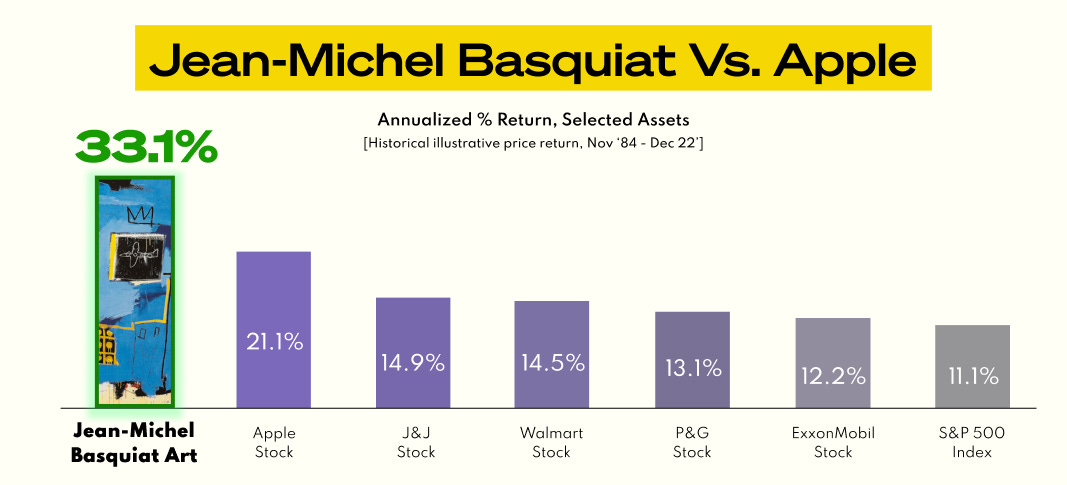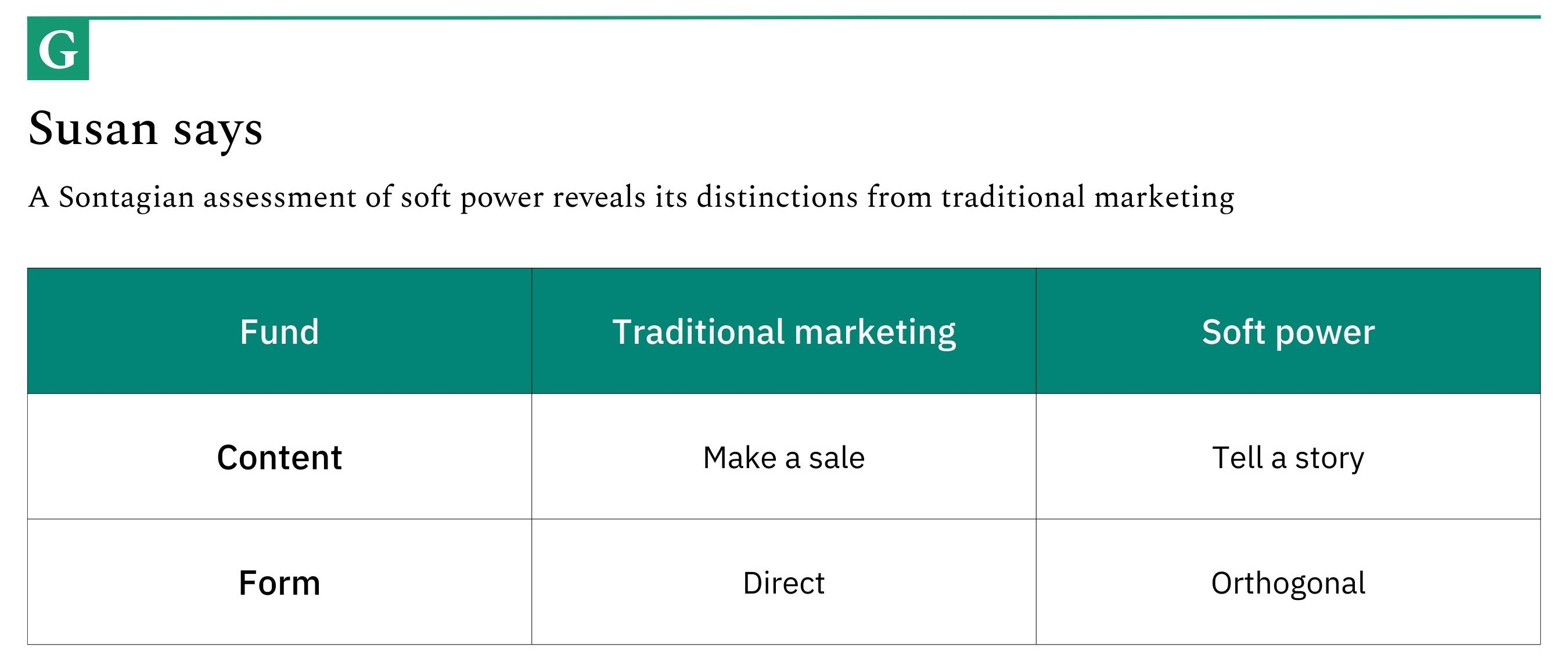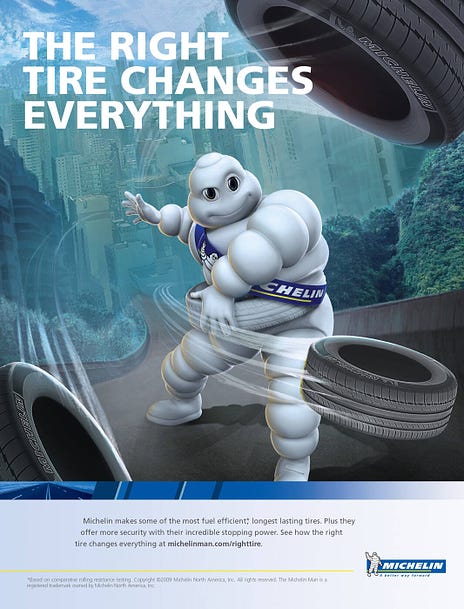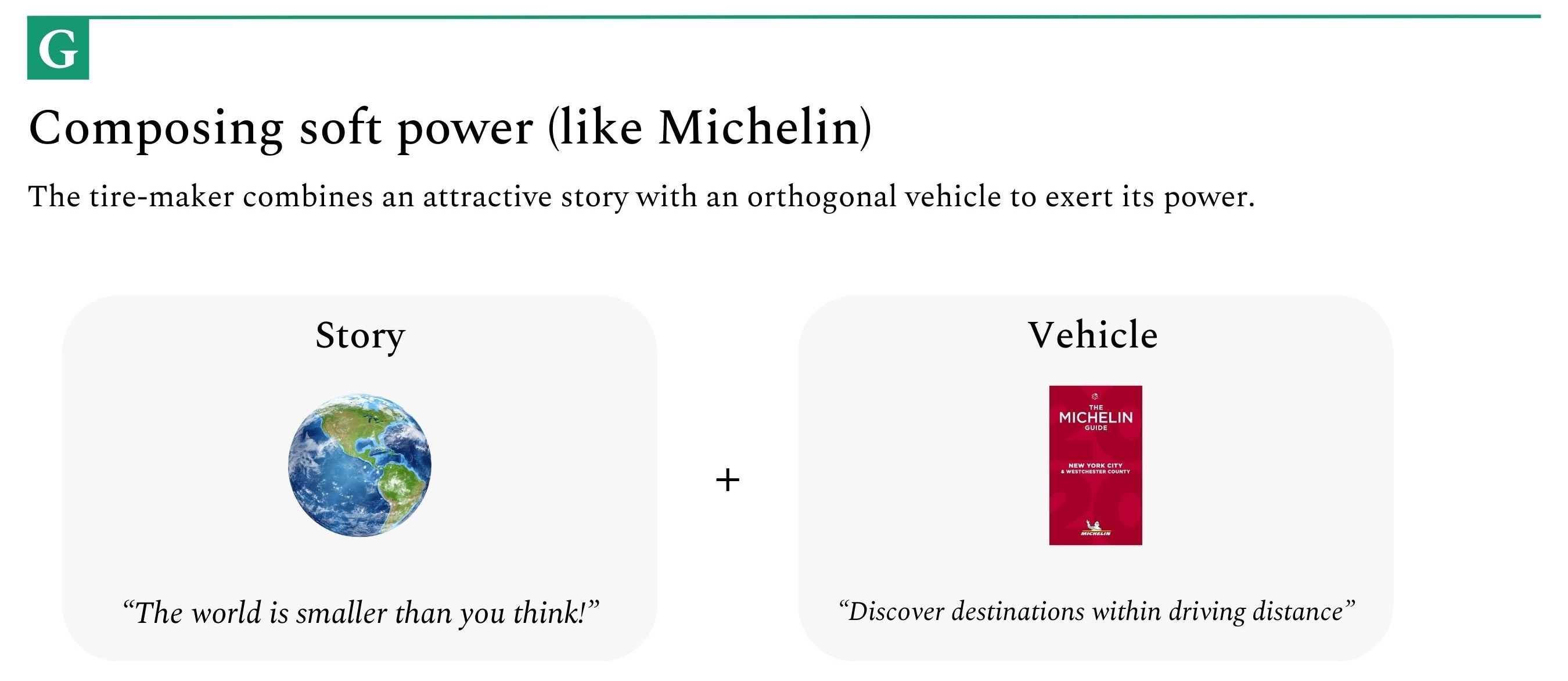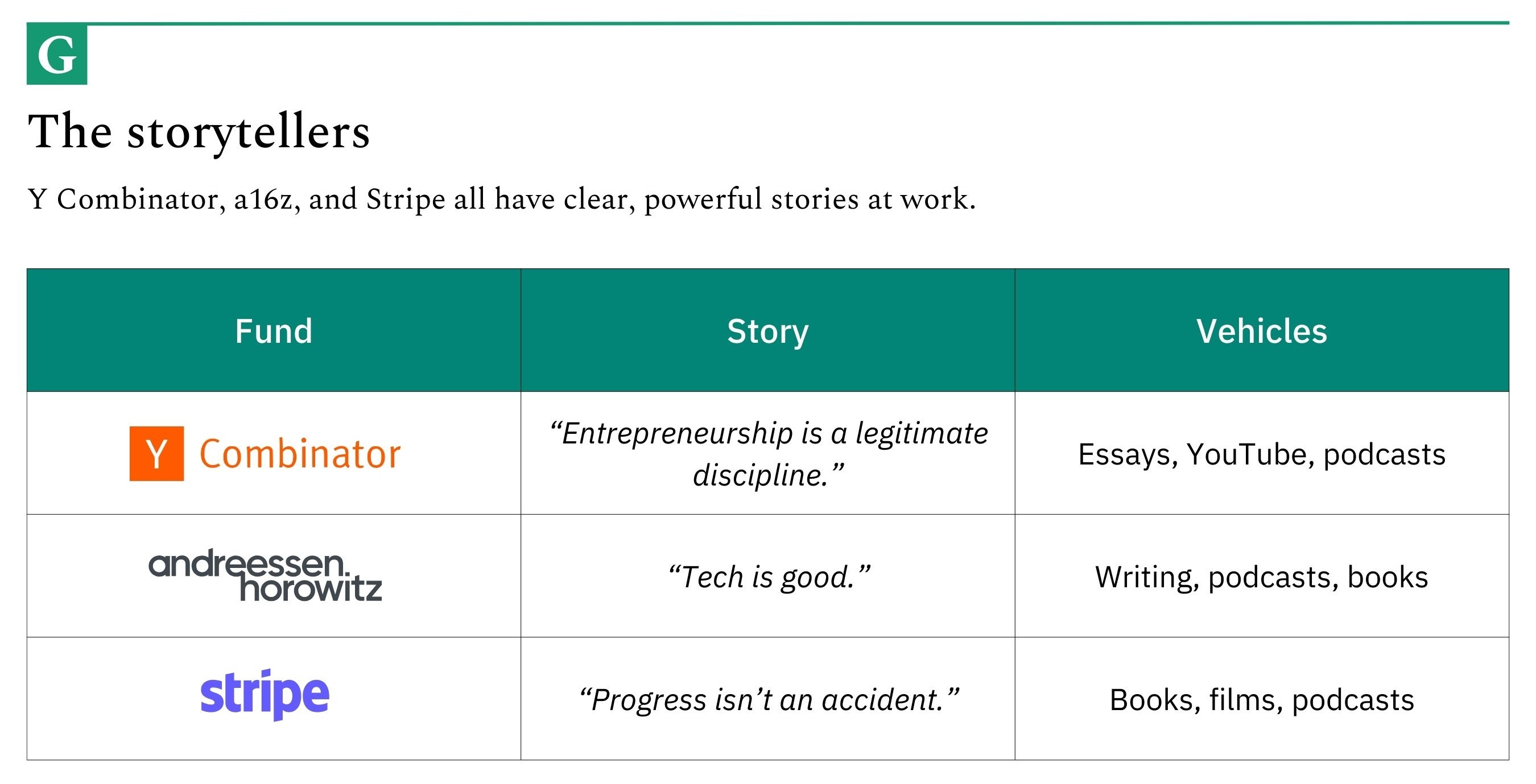The Generalist - Soft Power in Tech
Soft Power in TechStories move the world. Organizations that recognize this have the chance to exercise disproportionate influence.Friends, Stories move the world. The narratives we tell organize our culture, capital, and attention. Organizations that recognize this have the chance to exercise disproportionate influence. So, who in tech today is the best storyteller? Which company or venture fund has mastered the art of soft power? In today’s piece, we explore how soft power works, identify legendary examples, and highlight three tech titans that understand the power of narratives: Stripe, a16z, and Y Combinator. If you’re a long-time reader of The Generalist, this may sound familiar to you. Back in the summer of 2021, when this publication was much smaller, I wrote a piece on this subject. Today’s iteration is an update – one that hews as closely as possible to the original argument but relies on new, up-to-date examples. A small ask: If you liked this piece, I’d be grateful if you’d consider tapping the ❤️ above! It helps us understand which pieces you like best and supports our growth. Thank you! Brought to you by MasterworksThis surprising asset’s prices (handily) beat your favorite stocks It's not DUMBO real estate, rare electric vehicle metals, or Taylor Swift’s discography. In fact, you may have not even heard of this market. But it's a market that billionaires like Jay-Z and Ken Griffin have been clued into for decades: paintings by the famed artist Jean-Michel Basquiat. And now, for the first time, everyday investors are getting in on the action. Thanks to Masterworks, an award-winning platform for investing in blue-chip art. Their nearly $1 billion collection includes works by greats like Basquiat and Banksy, all of which are collectively owned by everyday investors. So far, each of Masterworks 16 sales out of its portfolio has realized a profit for investors. I’ve been investing with Masterworks since 2021 and have really enjoyed using the platform. My portfolio includes shares of paintings by world renowned artists like Picasso, Ruscha, and Rothko. All of their offerings are limited, and shares can sell out in just minutes, but readers can use The Generalist’s referral code to skip the waitlist. Actionable insightsIf you only have a few minutes to spare, here’s what investors, operators, and founders should know about soft power in tech.
André Michelin knew the problem: there weren’t enough cars. What was it now — 3,000 in the entire country? Less? Hardly enough to build a business around, particularly from the relatively small French city of Clermont-Ferrand. But along with his brother, Édouard, André was an innovator. Since taking over their grandfather’s virtually defunct hose manufacturer in 1886, the duo had resurrected Michelin through a series of deft moves. Chief among them was Édouard’s creation of the pneumatic tire, first for bicycles, then for automobiles. The younger brother’s invention had proven a marked improvement on the status quo, making replacing and repairing wheels significantly easier. It became the cornerstone of the revamped company. Still, the brothers kept running into the same problem: the market was too small. There were too few cars, and those that did exist weren’t driving enough. Few used their automobiles to take long journeys – the kind that would produce significant wear and tear and precipitate the purchase of new treads. André hatched a plan unusual in its far-sightedness and obliqueness: the company would launch a guidebook to promote travel by car. In 1900, the Michelin Guide was born. It proved to be an extraordinarily savvy business decision. Though it began as a free resource for motorists, featuring maps and automotive information, the Michelin Guide became a defining cultural and gastronomical resource. It succeeded in encouraging touring (and thus increasing the purchase of tires) and creating a story that others began to tell themselves. In that respect, Michelin’s move is perhaps the purest example of “soft power” applied to the corporate world. Rather than winning with might or money, the manufacturer appealed with its narrative. As the tech sector matures, this persuasion may become even more relevant. In the coming decade, we should expect startups of different sizes to develop soft power initiatives alongside their core offerings. Those who do will succeed in building distribution and popularizing the narrative that defines their business. They will create a story that wins. That can have wide-reaching effects, both vaporous and tangible. An introduction to soft powerIn the firmament of international affairs, few shine as brightly as Joseph Nye. Arguably, no thinker articulated power in the post-Cold War era better than the former dean of Harvard’s Kennedy School. In a 1990 edition of Foreign Policy magazine, Nye described the new methods of influence open to nation-states, coining the phrase “soft power.” Nye’s argument was that independent action was often untenable in an increasingly interdependent world. The “hard power” of military force or economic clout had diminished in the face of multi-nodal complexity:
For Nye, there was a clear alternative to this approach. If hard power won through coercion, soft power sought to seduce through influence. In a later address, Nye explicitly outlined this new source of strength:
Though most closely associated with foreign policy, Nye believed soft power applied to non-governmental organizations, including those in the private sector. While businesses didn’t exercise hard power in the same way as a nation might – Apple does not kick your door down and force you to buy an iPhone – soft power functions similarly. In the business world, shrewd executives know that leadership is not just a matter of issuing commands but attracting others to do what you want. This notion of attraction is critical to Nye’s definition:
This articulation makes it easier to place soft power in a business context. In citing examples of corporate soft power on Twitter, a common refrain arose: How is this different from marketing? Framing the inquiry in the world of this article, the question becomes: is the Michelin Guide just content marketing? Or is it somehow different? Is every bland, corporate Medium post an example of soft power, or is more needed to attain that descriptor? Let us try and answer the question. Invest in yourself Join The Generalist as a premium subscriber to unlock exclusive features designed to make you a better investor and thinker. That includes our correspondence with legendary founder and venture capitalist, Reid Hoffman on the craft of investing. To hear what Reid looks for in founders, why he backed Airbnb in the early days, and how he missed out on Stripe, join today and unlock our full conversations. Differences from marketingIn Against Interpretation, Susan Sontag argues that modern hermeneutics have destroyed our understanding of art. Rather than grapple with form – a work’s physicality and structure – we have become obsessed with content. This has left us incapable of genuinely seeing art, relying instead on short-hand interpretations. Our vision has become clouded by theory. Sontag’s framework is useful for distinguishing between traditional marketing and soft power. Here’s how both look from the perspective of content and form: Content“Politics in an information age may ultimately be about whose story wins,” Nye writes. In his words, we can see the core content-level discrepancy between marketing and soft power. That difference is roughly the distance between a sales pitch and a story. By definition, marketing content seeks to sell. The text is scripted, geared toward producing a specific outcome. It may do so subtly or bluntly, but ultimately, its content makes a demand: will you do this? For example, a Michelin ad looks something like this: It focuses on the product, enunciates its benefits, and seeks to drive toward a purchase. Soft power acts more gently, like a story. No explicit demand is made of the listener, and as a result, a state of openness is achieved. The content of soft power is often symbolic or metaphorical, enforcing values and norms through narrative. Browsing a Michelin guide, by contrast, operates subtly. Few references to tires are made. It is possible to peruse many of them without making a connection between the guide and its parent company. Rather than trying to drive a specific outcome, Michelin guides’ content bolsters the parent company’s story. It fortifies a worldview that might be summarized as The world is smaller than you think. Magic is within reach. The resonance of that story should lead to purchasing more Michelin tires, but that outcome almost seems like a coincidence. Though there may be occasional blurred lines, marketing and soft power rely on fundamentally different content types. One is a sale, the other a story. FormMarketing and soft power initiatives differ when it comes to form, each demanding a different vehicle. Since marketing aims to drive a specific outcome, it traditionally works best when closely tethered to the company. The goal in such circumstances is to minimize the distance between intent and purchase. To do that, things like brand recognition and proximity to the moment of purchase matter greatly. Soft power initiatives sit orthogonal to the central business, ostensibly unconcerned with driving a specific outcome. That may take the form of a guidebook like Michelin or something else. Podcasts, films, exhibits, and magazines are all viable formats. These mediums feel so out-of-kilter with modern digital marketing that it’s almost hard to take them seriously as attempts to generate tangible ROI. That makes them perfect, disarming vehicles for soft power plays. The lines are not perfectly drawn, but the above disambiguation gives us a practical definition of soft power and its difference from marketing. In short, it combines an attractive story (content) and an indirect vehicle (form). Beyond that, we can say that soft power looks to operate on a longer time horizon and pursues intangible value creation. That raises a new question: is it worth the trouble? Why bother?It hardly sounds like the most enticing endeavor: complex, high effort, and with an uncertain outcome. Why does anyone bother with soft power? Eroding advantagesIn the search for an edge, in a quest to influence customers, companies may have few better options. That’s thanks to the erosion of four strategic advantages upon which startups could once rely:
Although venture funding is down from its bull market peak, the asset class has undoubtedly grown over the past decade. In 2013, global venture funding totaled $25 billion. Last quarter alone, it surpassed $73 billion. Though its rise is not linear, the direction of travel is clear. The result of this proliferation is that it is harder than it used to be to build up a capital advantage. Even if a company raises hundreds of millions of dollars, its coffers are unlikely to put off motivated competitors or financiers. Hundreds of millions of dollars may have once looked unassailable; now, it’s simply validation. Other first-mover advantages have also diminished over the past decade. As tech has increased in popularity, industry information and parochial wisdom have spread. This makes it easier for willing entrepreneurs to identify promising ideas and fast-follow. In the process, they may leverage existing playbooks codified by former and current operators. Much of Silicon Valley’s implicit knowledge has been made explicit through dedicated outlets and social media. Faced with a pitched battle, startups often turn their resources toward acquisition. Here, too, competition has sanded away edges. Whereas once Facebook and Instagram marketing represented a relatively untested channel, making it particularly rewarding for those who mastered it, the world has caught up. Every large company now competes in these arenas, armed with millions of dollars and teams of relentless optimizers. The result is greater competition and higher costs. To compensate, some businesses have attempted to build up organic distribution channels. Rather than relying on paid marketing, these firms leverage their content marketing chops to develop followings on channels like TikTok, YouTube, Instagram, or Twitter. While there are certainly instances of considerable success, the increasing noisiness of these platforms makes breaking out difficult. Additionally, while this is not an example of “paid” marketing, it does not come for free. Doing it well requires considerable internal buy-in and resources. Ultimately, while ad dollars ensure some degree of visibility, no such promise exists for organic social posting. Companies often find themselves lost in a sea of brighter, funnier, more authentic voices. Narrative and magnetismTo present soft power as simply a last resort would be misleading. Though traditional advantages may be disappearing, exercising soft power represents an opportunity irrespective of their health. That’s because companies that popularize a compelling story about themselves create rare magnetism. By distilling its worldview into a phrase or meme (in the Dawkinsian sense of the word), companies earn enduring mindshare and develop a sense of destiny or mythology. Think, for example, of Stripe. What is the first phrase that comes to mind? I would guess some variation of “increasing the GDP of the internet.” That you know it at all is remarkable — how many payments companies have a story that rolls off the tongue? What is Adyen’s super-narrative? What is PayPal’s? That framing is part of a larger story Stripe is telling, bolstered by soft power initiatives. (We’ll discuss them a little later.) What has been the effect of that one articulation? Stripe would be successful without it, certainly. There is much more to that business than a tagline. But distillations like this can subtly alter the trajectory of a company. It’s a narrative that is magnetic to investors (simplifying the complexity of the product and enunciating an unusual, precise view of the internet), talent (advancing a desirable mission that feels worth working on), and the broader ecosystem (signaling this is not just a payments company). This is a slightly uncomfortable argument to be making in that it’s so utterly unprovable. And yet, if that phrase — and the rest of the story Stripe is telling — has simplified recruitment by just a few percentage points or convinced a few key investors, it will have had an extraordinary impact. As Nye noted:
Ultimately, soft power provides a smoothing of the terrain in front of you, a greasing of the wheels. To understand its impact, we must study its application. Modern mastersWe have by now established the composition of soft power and impact. To understand it fully, though, we must study its application. While our investigation focuses on the tech sector, starting with older examples can provide useful framing. Which well-known businesses have mastered the art of soft power? Drink brand Red Bull is one such example. As outlined in one of The Generalist’s most popular pieces, this company manufactures nothing. It does not even make its own drinks. Instead, Red Bull invests in crafting a mythology. It buys sports teams, sponsors athletes, and hosts competitions. In theory, none of these directly ask you to buy a can of sparkling caffeine – but all promote the maximalist lifestyle that Red Bull is interested in espousing. LVMH is another classic example, with a particularly interesting twist. It is both an agent and an instrument of soft power. Luxury purchases tend to be hard to justify from a purely rational perspective, no matter how exceptional the raw materials and craftsmanship. To elevate its work (and subtly vindicate its price tag), LVMH engages in all manner of soft power initiatives, producing short films, helping to launch a university, and hosting retrospectives for beloved painters like Mark Rothko. Through these projects, LVMH elevates the importance of its work and creates the idea that what it produces is not perfume, handbags, or clothing. It is art made slightly more accessible. This is LVMH as an agent of soft power; it is also an instrument. Increasingly, its products are seen as part of “Brand France,” how the rest of the world views the country. Former Minister of Culture Jack Lang – mentioned by Index’s Danny Rimer in a recent interview – highlighted the power of companies like LVMH in international affairs. “Foreign citizens might recognize France now by its brands and names,” Lang said. “It’s an opening. This path will lead them to writers; to the technology that’s advancing in many domains.” For France, LVMH is a way of solidifying a grand narrative. Who in the worlds of tech and venture capital have aced this art? In the current landscape, three organizations stand out as modern masters: Y Combinator, a16z, and Stripe. Each has a straightforward story and powerful vehicles through which it is shared. Y CombinatorThere are many startup incubators; there is only one Y Combinator. The organization that capitalized companies like Airbnb, Brex, Stripe, and Flexport has unique cultural power in Silicon Valley. Its motto of “Make something people want” has served as pragmatic inspiration for innumerable entrepreneurs. While that slogan serves as a worthy goal for its entrepreneurs, that’s not really the super-story it’s telling about the world. That might sound more like this: Entrepreneurship is a legitimate, learnable discipline that deserves attention from the world’s most ambitious people. YC is lucky that its leaders have tended to be masters of influence. Founder Paul Graham has written many of the best essays about entrepreneurship. His successor, Sam Altman, is another especially clear and compelling writer. YC’s core narrative is built and bolstered by its archives. New CEO Garry Tan, a prolific YouTuber, has brought a different flavor of influence to the organization. It has leaned away from its more literary, intellectual soft power initiatives to focus on broader mass-market mediums. Look at its website today, and in just a scroll or two, you’ll come across YouTube thumbnails that wouldn’t look out of place on Mr. Beast’s channel – complete with bold, san-serif fonts and emotive headshots. Head over to the incubator’s revamped Library, and you’ll see more of the same, with featured video and audio series prominently displayed. YC’s use of video is not new, of course. It has been publishing videos on YouTube for a decade; many of its most popular videos date back at least six years. However, how Tan appears to be emphasizing this medium – and productizing it – suggests a shift in approach. To YC’s credit, they have built up an impressively large audience, with over 1 million YouTube subscribers. Whether this approach appeals to you or not, you can see the strategy at play. Y Combinator wants its gospel to spread to the next generation of builders; to do that, it believes it must meet them where they congregate with a compelling narrative. A16zThough venture capitalists have spent much time and money on branding exercises and content marketing, definitive philosophies are uncommon. Plenty of websites are adorned with information on the kind of founders a firm seeks out or the help they offer. But seeing a VC articulate their beliefs about the world is unusual. (Thesis-driven funds sometimes get close, but these usually map out a commercial opportunity rather than disclose an overriding ontology.) A16z is the rare VC with an attractive, crystalline story: technology is good. Entrepreneurship and innovation move the world; those who build are worthy of high esteem. While Marc Andreessen’s “Techno-Optimism Manifesto” is the most direct example of this philosophy, the firm has been advancing it for years. “Software is eating the world” and “It’s time to build” are earlier variations on this theme. PuzzlerRespond to this email for a hint. This week, we’re mixing things up with a bit of classic tech trivia:
Tremendous work from this collection of riddlers that supplied the correct answer and several that made me chuckle: Shashwat N, Austin V, Bruce G, Joel O, John G, Noah F, Gary J, Rob N, Michael O, Krishna N, Jeffrey B, Scott M, Abhay G, Vedant M, and Emerson K.
The stated answer? Your word or a promise. Others that work? A cold, “several diseases,” a secret, love, your address, and knowledge. Until next time, Mario ___ Investing involves risk and past performance is not indicative of future returns. See important Reg A disclosures and aggregate advisory performance masterworks.com/cd You're currently a free subscriber to The Generalist. For the full experience, upgrade your subscription. |
Older messages
Reid Hoffman on the psychology of great founders
Tuesday, December 5, 2023
In the second edition of our “Letters to a Young Investor” series, Reid Hoffman discusses exceptional entrepreneurs and their intersection with promising markets.
The Best Venture Firm You’ve Never Heard Of
Sunday, December 3, 2023
Hummingbird Ventures has built an astonishing track record – all while staying out of the limelight. Its secret to success? A meticulous approach to identifying outlier founders.
A Special Thank You – and Special Offer
Monday, November 27, 2023
Get a discount on everything The Generalist has to offer!
How do you hire upwards?
Tuesday, November 21, 2023
The OpenAI drama has left a hole in the company's upper echelons. Its remaining leaders now face a daunting task that every founder must reckon with: recruiting exceptional senior talent.
Ask Mario: The VC bubble, the value of specialization, and business case studies.
Tuesday, November 14, 2023
The first edition of our new Q&A series.
You Might Also Like
🚀 Ready to scale? Apply now for the TinySeed SaaS Accelerator
Friday, February 14, 2025
What could $120K+ in funding do for your business?
📂 How to find a technical cofounder
Friday, February 14, 2025
If you're a marketer looking to become a founder, this newsletter is for you. Starting a startup alone is hard. Very hard. Even as someone who learned to code, I still believe that the
AI Impact Curves
Friday, February 14, 2025
Tomasz Tunguz Venture Capitalist If you were forwarded this newsletter, and you'd like to receive it in the future, subscribe here. AI Impact Curves What is the impact of AI across different
15 Silicon Valley Startups Raised $302 Million - Week of February 10, 2025
Friday, February 14, 2025
💕 AI's Power Couple 💰 How Stablecoins Could Drive the Dollar 🚚 USPS Halts China Inbound Packages for 12 Hours 💲 No One Knows How to Price AI Tools 💰 Blackrock & G42 on Financing AI
The Rewrite and Hybrid Favoritism 🤫
Friday, February 14, 2025
Dogs, Yay. Humans, Nay͏ ͏ ͏ ͏ ͏ ͏ ͏ ͏ ͏ ͏ ͏ ͏ ͏ ͏ ͏ ͏ ͏ ͏ ͏ ͏ ͏ ͏ ͏ ͏ ͏ ͏ ͏ ͏ ͏ ͏ ͏ ͏ ͏ ͏ ͏ ͏ ͏ ͏ ͏ ͏ ͏ ͏ ͏ ͏ ͏ ͏ ͏ ͏ ͏ ͏ ͏ ͏ ͏ ͏ ͏ ͏ ͏ ͏ ͏ ͏
🦄 AI product creation marketplace
Friday, February 14, 2025
Arcade is an AI-powered platform and marketplace that lets you design and create custom products, like jewelry.
Crazy week
Friday, February 14, 2025
Crazy week. ͏ ͏ ͏ ͏ ͏ ͏ ͏ ͏ ͏ ͏ ͏ ͏ ͏ ͏ ͏ ͏ ͏ ͏ ͏ ͏ ͏ ͏ ͏ ͏ ͏ ͏ ͏ ͏ ͏ ͏ ͏ ͏ ͏ ͏ ͏ ͏ ͏ ͏ ͏ ͏ ͏ ͏ ͏ ͏ ͏ ͏ ͏ ͏ ͏ ͏ ͏ ͏ ͏ ͏ ͏ ͏ ͏ ͏ ͏ ͏ ͏ ͏ ͏ ͏ ͏ ͏ ͏ ͏ ͏ ͏ ͏ ͏ ͏ ͏ ͏ ͏ ͏ ͏ ͏ ͏ ͏ ͏ ͏ ͏ ͏ ͏ ͏ ͏ ͏ ͏ ͏ ͏ ͏ ͏ ͏
join me: 6 trends shaping the AI landscape in 2025
Friday, February 14, 2025
this is tomorrow Hi there, Isabelle here, Senior Editor & Analyst at CB Insights. Tomorrow, I'll be breaking down the biggest shifts in AI – from the M&A surge to the deals fueling the
Six Startups to Watch
Friday, February 14, 2025
AI wrappers, DNA sequencing, fintech super-apps, and more. ͏ ͏ ͏ ͏ ͏ ͏ ͏ ͏ ͏ ͏ ͏ ͏ ͏ ͏ ͏ ͏ ͏ ͏ ͏ ͏ ͏ ͏ ͏ ͏ ͏ ͏ ͏ ͏ ͏ ͏ ͏ ͏ ͏ ͏ ͏ ͏ ͏ ͏ ͏ ͏ ͏ ͏ ͏ ͏ ͏ ͏ ͏ ͏ ͏ ͏ ͏ ͏ ͏ ͏ ͏ ͏ ͏ ͏ ͏ ͏ ͏ ͏ ͏ ͏ ͏ ͏ ͏ ͏ ͏ ͏ ͏
How Will AI-Native Games Work? Well, Now We Know.
Friday, February 14, 2025
A Deep Dive Into Simcluster ͏ ͏ ͏ ͏ ͏ ͏ ͏ ͏ ͏ ͏ ͏ ͏ ͏ ͏ ͏ ͏ ͏ ͏ ͏ ͏ ͏ ͏ ͏ ͏ ͏ ͏ ͏ ͏ ͏ ͏ ͏ ͏ ͏ ͏ ͏ ͏ ͏ ͏ ͏ ͏ ͏ ͏ ͏ ͏ ͏ ͏ ͏ ͏ ͏ ͏ ͏ ͏ ͏ ͏ ͏ ͏ ͏ ͏ ͏ ͏ ͏ ͏ ͏ ͏ ͏ ͏ ͏ ͏ ͏ ͏ ͏ ͏ ͏ ͏ ͏ ͏ ͏ ͏ ͏ ͏ ͏ ͏ ͏ ͏ ͏ ͏ ͏

